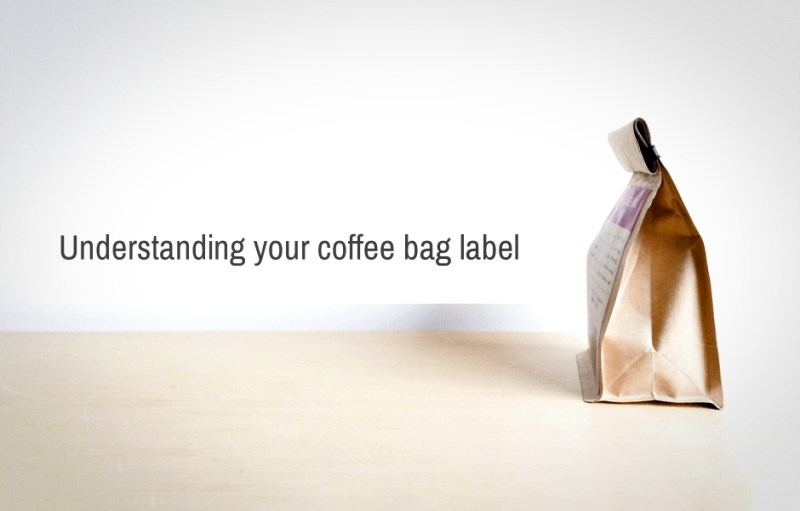
Have you taken a good look at the label on your coffee lately? Today’s specialty coffee roasters are especially proud of the coffees they offer. Most work hard to source coffees that meet specific standards – coffees that are grown sustainably, traded responsibly and taste amazing in your cup. They also understand that today’s coffee consumers aren’t content with a fancy name and a brand label. We want to know more about what we’re drinking, where it came from, how it was grown and who touched it on the way to our cups. If you know where to look, you can generally find all of that information – and often more than that – on the coffee label. Not sure what all those little seals and strings of alphabet soup on your bag of coffee mean? Here’s a quick translation guide that will help you navigate the world of coffee bag labels:
What’s in a Name?
The name of the coffee can tell you a lot about what’s in the bag. Take for example, CREMA’s El Salvador, Las Delicias Pacamara Reserve. The name tells you that the bag holds a single origin coffee from the Las Delicias region of El Salvador, and that all the beans are a single variety – Pacamara. The “reserve” label suggests that it’s a special lot of coffee, probably a microlot. The name of a coffee might also include the estate, like Cuvee Coffee’s Fazenda Pantano, or the producer, like West Bean’s Rwanda Musasa Dukundekawa Cooperative. It may include a grading term, like Kenya AA, Guatemala SHB (strictly hard bean) or SHG (strictly high grown), tell you that it’s a blend or even suggest the best way to brew it.
Roast, Blend and Cupping Notes
The coffee label should carry the roast date somewhere on it. Many roasters use a sticker, while others will write it or stamp it on the bag itself. If the coffee is a blend, the label may list the origin coffees included. You may find information about how the coffee was processed – dry, wet, natural, honey and pulped are all terms that refer to processing. Many roasters include an indicator of roast level – light, medium or dark are common, but some get even more granular. Finally, lots of roasters now include flavor or cupping notes on their coffee labels to help you choose and enjoy the coffees you like most.
Coffee Certification Seals
Responsible Sourcing
Fair Trade, TransFair USA, World Fair Trade Organization
There are several organizations that provide some variation of a fair trade label. They include Fairtrade International, TransFair USA and the World Fair Trade Organization. They all guarantee that coffee growers were paid a minimum price for their coffees and offer various other assurances about the treatment of laborers. You can learn more about each of these certifications in the Coffee Kind library.
Sustainable Growing
USDA Organic, Rainforest Alliance, Bird Friendly
USDA Organic is awarded to coffee growers who prove that they do not use inorganic chemicals in growing their coffees and meet other specific standards outlined by the USDA.
The Rainforest Alliance Certified seal guarantees that the coffee in the bag was grown and harvested using socially, economically and ecologically sustainable methods.
The Smithsonian Migratory Bird Center developed the Bird Friendly certification standards to encourage the preservation of biodiversity and the healthy ecosystem required by migrating birds and other native animals. In order to bear the Bird Friendly label, coffees must meet specific standards of shade grown and be certified USDA Organic.
Other Label Designations
Direct Trade, directly traded or relationship coffee all refer to coffee that has been bought directly from the coffee grower rather than going through one or more layers of middle men.
Single Origin coffees are coffees from one particular region, country or growing area. It’s a much broader term than estate coffee, which designates coffee grown on a particular farm or estate, or microlot, which refers to coffee from a specific area on a specific farm grown during a specific season.
Awards
Cup of Excellence (CoE) competitions are like Miss Universe pageants for coffee beans. They’re held in a growing number of coffee producing countries and regions around the world. If you see the CoE cup on the label, you know you’re getting one of the finest coffees out there.
The Brewers Cup competition is rapidly gaining visibility in the specialty coffee world. While the awards actually go to the baristas who prepare the coffees, it’s considered a high honor to be chosen as an official Brewers Cup coffee.
Cupping Scores are awarded on a 100-point scale to the roaster, taking into account flavor, aroma, body and acidity. Coffees that score higher than 90 points in CoE competitions or achieve high scores from Coffee Review often carry their 90+ point score on the label or in their advertising.
The Good Food Award is new, but it’s becoming a high honor for a coffee to place in the Coffee category. The Good Food Coffee awards are given to specific coffees from specific roasters.

Editors' Recommendations
- How to achieve the perfect pour-over coffee to complete your morning routine
- Nestlé’s environment-friendly initiatives will make you feel good about your daily cup of coffee
- The 8 Best Coffee Subscriptions to Satiate Your Caffeinated Desires
- The 10 Best Thermoses to Keep your Coffee Fresh
- 9 Best Cold Brew Coffee Makers to Get Your Chilled Buzz On in 2022


